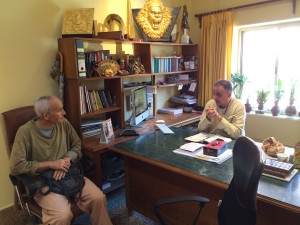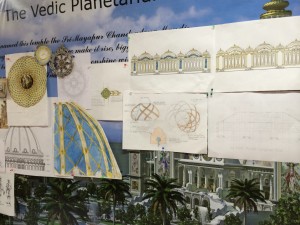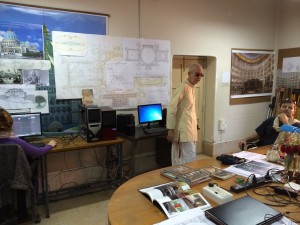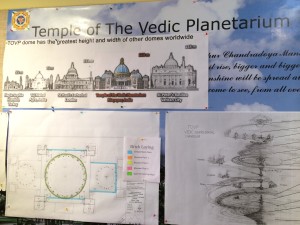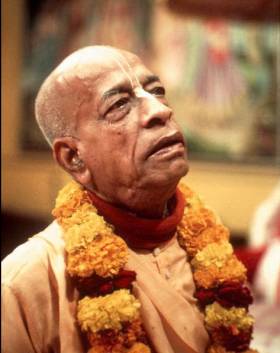The devotees working at the ToVP offices in Mayapur will be very busy in the coming years finishing off not only designs for the main structure but for the internal and external ground plans as well.
ToVP
The Whole Second Canto in Fifteen Minutes!!!
→ The Enquirer
Originally posted on Bhagavatam By Braja:
Please read my book, Beautiful Tales of the All-Attractive, Volume 2.
The Whole Second Canto in Fifteen Minutes!!!
→ Bhagavatam By Braja
SB 01.05.27 – Taste for Krishna comes by using the gross and subtle bodies in his service and it helps us use those bodies for the perfect purpose
→ The Spiritual Scientist
SB 01.05.27 – Persist prayerfully in mind control while the holy name does mind conversion
→ The Spiritual Scientist
Nityananda Mahajana by Gaurangi
→ ISKCON News
New Vrindaban Daily darsan @ February 11, 2014.
→ New Vrindaban Brijabasi Spirit
Although the opulences of liberation clutch his feet, he runs to hell. After obtaining a cintamani jewel, he throws it in the ocean. After making the Supreme Personality of Godhead his submissive servant, he becomes the lowest dog. Such is a person who, after attaining Vrndavana, again leaves.
[Source : Nectarean Glories of Sri Vrindavana-dhama by Srila Prabodhananda Sarasvati Thakura, 1-60 Translation.]
Remembering Srila Prabhupada in Surat
→ travelingmonk.com
Do Not Chant Like The Parrot
→ Japa Group
From Japa Reform Notebook
by Satsvarupa dasa Goswami
Jaya Nityananda Rama!
→ KKSBlog
(Kadamba Kanana Swami, 14 February 2003)
 The lotus feet of Lord Nityananda are essential. Without the lotus feet of Lord Nityananda, one cannot ever get the mercy of Radha and Krsna. In another words, one cannot ever be an eligible candidate to go back to the spiritual world. We need that mercy of Lord Nityananda.
The lotus feet of Lord Nityananda are essential. Without the lotus feet of Lord Nityananda, one cannot ever get the mercy of Radha and Krsna. In another words, one cannot ever be an eligible candidate to go back to the spiritual world. We need that mercy of Lord Nityananda.
HG Narottamananda Prabhu / SB 10.54.47
→ Kalachandji's Audio Archive
HG Mahahari Prabhu / Appearance Day of Sri Advaita Acarya
→ Kalachandji's Audio Archive
HG Nityānanda Chandra Prabhu / Sri Brahma-samhita
→ Kalachandji's Audio Archive
Darshan Room Kirtan Anniversary Party
→ Nityananda Chandra Das' Blog, ISKCON Dallas
Last Wednesday we celebrated our anniversary of The Darshan Room
What is The Darshan Room you ask? The Darshan Room is weekly event that taps into the giving newcomers the essence of the Krishna Consciousness experience. Uplifting kirtan, dynamic discussions, and an absolutely amazing vegetarian feast.
Many similar venues have been developed throughout the US such as Krishna Lounge in San Diego, Krishna House in Denver, and the traveling Pilgrim’s Lounge in Oakland.
We had a wonderful class given by Nityananda Prabhu our temple president and rousing kirtans by Kalindi Patel.
Everyone had a wonderful time. Here are some responses.
“I had such a beautiful night yesterday. Thank you for everything.”
“Hare Krishna brother, much love to you and thank you for awesome gathering at the darshan room last evening! so much blessings”
“Having the best celebration of my life!”
“Man the Wednesday program was awesome!!!! nice to see Reivin Alexandria after a LONG time ”
“I enjoyed it, as always
“










Hare Krishna!!!
14 Feb 2014 – Sri Krishna Madhura Utsava
→ ISKCON Desire Tree
14 Feb 2014 – Appearance Day of Srila Narottama Dasa Thakura
→ ISKCON Desire Tree
The Darshan Room Anniversary Kirtan Party, Iskcon Dallas (6 min video)
→ Dandavats.com
 Nityānanda Chandra Dās: The Darshan Room is weekly event that taps into the essence of the Krishna Consciousness experience. Uplifting kirtan, dynamic discussions, and an absolutely amazing vegetarian feast. Read more ›
Nityānanda Chandra Dās: The Darshan Room is weekly event that taps into the essence of the Krishna Consciousness experience. Uplifting kirtan, dynamic discussions, and an absolutely amazing vegetarian feast. Read more › ISKCON’s amazing festivals
→ simple thoughts
Over the past couple of day’s I’ve been getting ready for up and coming visits to primary schools which are always interesting.
Unlike high school’s there is no direct learning outcomes set by SACRE (Standing Advisory Committee on Religious Education) which frees the primary teachers to explore in their own unique manor; those requesting visits have asked me to cover festivals.
Which raises a unique challenge, I cannot just put together one presentation that covers all; (a one size fit’s all approach which many feel comfortable with) but a multiple layered approach given the vast age range.
Reception class is by far the easiest a nice story played out, kirtan and cake Yummy! We like cake
But as the ages increase so does the learning outcomes, but festivals are a difficult one there are so many, some connected by the same story but cover different event’s. Do I present in chronological order as we celebrate or connected to the story? I ponder!
It also allowed me to do one thing, research into each festival, it’s significance, the story behind it and also how different groups celebrate and what it means to them.
During my research one notation or theme recurred: this festival had all but died out and was re-invigorated by the International Society For Krishna Consciousness who made it part of their calendar and promoted it’s importance.
Yes Srila Prabhupada’s white elephants, the ragtag hippies who became happiest when serving Srila Prabhupada’s mission; and yes they didn’t always get it quite right Govardhan Hill is an example of that but non the less it enthused and made many realize what a wealth of joy and happiness can be gained by a little Kirtan, Prasadam, dressing the deities nicely, play’s and recitation of the stories.
Lovely.
And it reminded me of this, it is not that we turn to others to maintain this tradition of celebrating Sri Krishna’s pastimes but ours we should be that enthusiastic to share our festivals with everyone; which means we need to get involved.
So next time your at the Temple/preaching centre ask what do you want me to do next festival?
Being a part of the work involved is as rewarding to just turning up on the day for Kirtan and prasadam; indeed you gain more as you get amazing association in it’s run up. The association is magical enough
I hope that in my small presentation to the primary schools may be they too can join in the Diwali celebrations indeed may it become a tradition that everyone no matter what their background becomes so enthused by Srila Prabhupada’s white elephants that they all join in.
Hare Krishna
January 2014
→ 16 ROUNDS to Samadhi magazine
Abhisheka ceremony of Advaita Acarya in Mayapur dhama (86 beautiful, high resolution photos)
→ Dandavats.com
 Jayapataka Swami: So, today is a good day to follow in the footsteps of Krishna Das Kaviraj and take shelter of Advita Gosai who was incarnation of a devotee. Lord Caitanya is devotee, Nityananda is expansion as his devotee, Advaita Acharya is the incarnation of devotee. When Lord comes, he is always supreme personality of God Head. In this Lila He is supreme personality of Godhead, and simunteously He is supreme personality of devotee. He is combined form of Radha and Krishna. He has special power which even Advita Acharya did not have, Advita Acharya could give liberation but to give love of Godhead is bit more difficult which only can Lord Chaitanya can offer. Read more ›
Jayapataka Swami: So, today is a good day to follow in the footsteps of Krishna Das Kaviraj and take shelter of Advita Gosai who was incarnation of a devotee. Lord Caitanya is devotee, Nityananda is expansion as his devotee, Advaita Acharya is the incarnation of devotee. When Lord comes, he is always supreme personality of God Head. In this Lila He is supreme personality of Godhead, and simunteously He is supreme personality of devotee. He is combined form of Radha and Krishna. He has special power which even Advita Acharya did not have, Advita Acharya could give liberation but to give love of Godhead is bit more difficult which only can Lord Chaitanya can offer. Read more › Yogi Walks On Water
→ 16 ROUNDS to Samadhi magazine
Based on story told by Srila Prabhupada
One person was traveling away from home for ten years, and he went to the Himalayas to find a yogi who could give him some perfection.
It is quite natural that any person who achieves some success wants to show it off before friends, relatives, and countrymen. So, after ten years, he came back to his village. All the villagers assembled and were very anxious to know what had happened to him.
“My dear friend, for ten years you have been searching, trying to learn yoga perfections. So what have you learned? Please let us know.”
He said, “I have achieved the laghima-siddhi perfection. That means I have learned how to become the lightest.” And what is the result? He said, “I can walk on water.”
So everyone was very anxious because people are very inquisitive and curious. So they requested him, “Let us have some demonstration. Please show that you’ll walk over the river.”
“All right, I shall show you tomorrow morning.”
In the village lived an old man. He said to the yogi, “My dear such-and-such, after working for ten years, you have learned something that is two cents worth.”
The yogi was very angry. “Oh, it is two cents worth, you think?”
“Yes, I think it is two cents worth.”
“Why?”
“Because you’ll walk over the river, but I shall pay the boatman two cents and I too will cross over the river.”
So these things are two cents worth in comparison to Krishna consciousness. Don’t be after them. Real yogic perfection means to achieve liberation from material existence by developing spiritual, Krishna consciousness. One may attain one of the eight yogic perfections such as becoming smaller than the smallest or heavier than the heaviest, and make a wonderful show of material nature, but because such a mind is still on the material platform, such a person will still have to stay in the cycle of repeated birth, death, old age, and disease.
Bhagavad-gita (6.47) reiterates this point:
“And of all yogis, he who always abides in Me with great faith, worshiping Me in transcendental loving service, is most intimately united with Me in yoga and is the highest of all.”
Suicide of the Soul
→ 16 ROUNDS to Samadhi magazine
Squirt Guns, Yogis, and Moksha
There are many possible motives for suicide. Saintly people, for example, sometimes commit suicide to atone for some serious mistake or as an involuntary expression of some extremely deep emotion.
Cota Haridās drowned himself in a sacred river as an expression of spiritual grief.
Sanātana Goswāmī planned to kill himself under the juggernaut-wheels of a huge sacred cart.
Raghunātha Goswāmī attempted suicide by leaping from the cliff of a sacred hill.
Śiva’s wife, Sati, for example, committed suicide out of grief of being related to her father, who had disrespected her husband.
The result of suicide, like everything, depends on the motive. Sati’s result was that she became Parvatī, married Śiva again and was free from her inglorious previous family/father. This shows that suicide does not always have a negative result.
Almost always, however, suicide is an unrecognized expression of the desire for moksha (spiritual liberation). The pains and depressing, inescapable realities of existence become too great to bear; they vastly outweigh the joys and pleasures of life – one decisively prefers not to exist at all, rather than exist amidst such unbearable circumstances.
Since the desire for moksha is unrecognized, the individual seeks to end their existence by some physical means – a bullet, a pill, a blade, a steep drop, etc. If the desire were recognized as a desire for moksha the individual would instead recourse to nihilistic spiritual disciplines to extinguish his or her existence altogether – a much more effective form of suicide – since it destroys not just the physical self, but also the emotional self.
What destination is attained by a person who physically kills themselves?
It depends on their consciousness at the time of death. yat yat vāpi smaran bhāvam tajantyante kalevararam – “Whatever your heart is absorbed in when you die will become the general condition of your next birth.” (Bhagavad Gita 8.6)
Not always, but most often the consciousness of a person committing suicide is tragic and filled with negative emotions. Therefore most often, the destination of those who commit suicide is tragic. It is not always the case, but it is arguably the norm. When a person dies with a lot of unfinished, unresolved emotional ties to people, places, and things in their life, they will find themselves unable to move on to their next birth. A suicidal person, specifically, will also be loathe towards the proposal of starting the whole depressing cycle over again in another birth. When the mind is paralyzed from moving on to the next life, the being has to exist for a while without a physical form, only in an emotional “body” – a very troubled emotional body.
People tend to experience such beings as “ghosts” and so on. Often, people who commit suicide have many, many unresolved issues with their life, thus it is quite frequent that suicide produces what many people call “ghosts.”
Another problem is that suicide most often leaves behind unfulfilled responsibilities. This is a serious karmic problem incurred by committing suicide. If a person is old, legitimately renounced, or somehow has fulfilled or never incurred many familial and social responsibilities, this may not be an issue.
Eventually (it can take centuries) the ghost forgets his or her negative ties to the previous life and drifts slowly towards another birth. In that next birth they will have to again deal with what they wanted to escape: being alive in a painful world.
If a person recognizes the suicide impulse as the desire for moksha and fulfills that impulse not by physical suicide, but by “spiritual” nihilism – what is the result?
Another type of “ghost” – really.
They extinguish their false existence, which is good, but they do so with a sense of disgust, disdain, frustration, or repulsion. These negative motives invariably generate negative results. The result of such moksha is to obliterate one’s false being, but not attain any true being – a type of ghostly existence in a sense, in between falsehood and truth, and neither of either. Like a ghost, they exist for sometime without any tangible existence. Eventually, the negative, unresolved emotional ties to the false world will again pull them into subdividing their consciousness into negative existence and they will again acquire a material birth.
In the end, suicide of either type fails to solve the problem. You eventually have to actually face your problems and solve them. The problem is suffering. Self-centered existence is the root of suffering. Selfless existence is the end of suffering and the root of joy. “Selfless existence” means an existence of pure love. Pure love is realized in its most perfect zenith when the beloved is absolutely pure and real – focused on the absolute reality as the supreme beloved.
The only real way to end suffering is love – bhakti. Practice of bhakti is the only way to accomplish what suicide would like to accomplish, but cannot.
Appearance of Advaita Acharya
→ Mayapur.com
Please view the following galleries: Abhishek Darshan Appearance day lecture of Advaita Acarya by HH Jayapataka Swami. So, today is a good day to follow in the footsteps of Krishna Das Kaviraj and take shelter of Advita Gosai who was incarnation of a devotee. Lord Caitanya is devotee, Nityananda is expansion as his devotee, Advaita […]
The post Appearance of Advaita Acharya appeared first on Mayapur.com.
Village Life
→ 16 ROUNDS to Samadhi magazine
The following is taken from a lecture Srila Prabhupada gave in Hawaii on May 25, 1975
The glaring attraction of the city is maya. In the modern age people are attracted by city life, but we should know that city life is not for the devotee (or any other transcendentalist); generally, people like city life, but that is maya. Maya means “that which is not a fact” or that which is an illusion. We are under the spell of maya, thinking that by living in the city we shall be happy.
One English poet, Cowper, said that a city is made by men, but a village is made by God. So, if you can stick to village life you can produce your necessities and be satisfied with whatever you produce. If we keep cows and grow food grains, fruits, and vegetables, then we can live very peacefully. There is no need of going to the city. That is the plan of God, Krishna.
Krishna personally exhibited living in a village. Vrindavana is a village; it is not a city. We are trying to go to the village of Krishna — Vrindavana.
Formerly one was considered to be rich if one possessed many cows:. Now, artificially, the society has made a promise that if you can possess some paper – a hundred dollars, five hundred dollars, a thousand dollars, then you are rich. But actually that is not wealth. When there is no food, you cannot eat this paper no matter how much it may be worth – a hundred dollars, five hundred dollars, etc. But if one possesses grains and cows, then one will never starve. The city people, who have money, are getting food supplies from remote villages. Thus they are dependent whereas the farmers are free.
Money means paper, which they are using to cheat people. There is no money really, but they have made an economic condition in such a clever way that we are accepting this paper as money. We are being misled to think we need money to obtain so many material possessions that the city offers so that we can live properly and be happy. They are mostly superfluous things. Real riches are actually the grains and milk. Those are real riches; according to Vedic civilization it is said, dhanyena dhanavan gavaya dhanavan.
So the Krishna consciousness movement is designed to teach everyone that we should not be attracted by false things. City life is like fool’s gold.
Produce your own food; keep cows, and milk. And, if you produce cotton, you can produce your own cloth also.
That is an actual civilization. You are all Europeans and Americans, and are not accustomed to it. But if you develop the civilization of plain living and high thinking, and save time for advancing in Krishna consciousness, you will achieve the real success of life.
Comfortable means without anxiety. That is life. Real life is without anxiety. That is comfortable living. If you are living and sleeping in a very high skyscraper building, but full of anxiety, is that a comfortable life? That is not a comfortable life. Canakya Pandita, regarded as a greatly wise man in India, has said that a comfortable, happy person is one who does not have to go too far from home to work and who is not a debtor. He is happy. However, in the city everyone are debtors, and they have to go fifty miles, a hundred miles, etc. for earning livelihood. Is that comfortable? The bank is ready to give you money – “Purchase motorcar. Purchase this. Purchase that.” And at the end of the month, after working hard to get a salary, all of the money is taken by the bank, and again you have to work. So you are a debtor and full of anxiety; is that a comfortable life? No, that is not a comfortable life. A comfortable life means no anxiety.
So you have got this land. Don’t go away. Develop it. That is my instruction. Keep cows. Produce your own food and thus save time for spiritual life. This is perfect. You don’t require a technical education and this education, that education, wine, meat. That is a hellish civilization. That is not human civilization.
Read Bhagavad-gita and Srimad Bhagavatam; produce your own food; live peacefully. What is the use of going to the city? Bhaktivinoda Thakura (a modern saint and writer) said that this material way of life, material advancement of civilization, means giving an advantage to illusion to increase its influence over us.
So be satisfied with a humble life in the village and be advanced in spiritual consciousness. That is the real profit of life. Don’t be misled by the glaring, dazzling situation of the city. It is not worth it.
Why Do We Misidentify With The Mind?
→ 16 ROUNDS to Samadhi magazine
A Ventriloquist’s Show
Ventriloquism is the art of projecting one’s voice so that it seems to come from another source, say a dummy. Those unaware of ventriloquism mistakenly think that the inanimate dummy is speaking, but those aware can figure out what’s actually happening.
The mind is a most crafty ventriloquist. While ordinary ventriloquists may perform a show for us to see, the mind makes us its show. Ordinary ventriloquists may project their voices to inanimate objects for the entertainment of onlookers, but the mind projects its voice onto us and makes us believe that its voice is our voice. Because we are often unaware of the mind’s insidious tactics, we fall prey to its ventriloquism and act out its selfish desires, assuming that they are our desires. Only later when the short-lived pleasure of acting out ends and the consequences start becoming evident do we ask in dismay: “Why did I do that? It was so against my values. I never wanted to do that. Yet I did it. Why?” It was due to the mind’s deceitful ventriloquism.
How do we protect ourselves?
By stopping the mind when it is speaking in the second person (“you do this and enjoy”) and not letting it take on the first person voice (“I want to do this and enjoy”). To understand this, let’s explore the ventriloquism metaphor further.
When ventriloquists make a dummy speak, they have to be present somewhere nearby; the voice can’t be projected over long distances. If onlookers are informed and alert, they can, as soon as they hear the dummy speaking, look around, spot the ventriloquist and say, “That’s you speaking.” By thus catching the ventriloquism in the act, they can avoid getting deluded.
Similarly, the mind has to be in our vicinity before it can make us misidentify with it. Of course, ontologically speaking, the mind is always in our vicinity; it exists inside us. But functionally speaking, the mind is not always aroused and active with its nefarious schemes; it’s not always a ventriloquist in the act.
When the mind becomes captivated by some unhealthy fancy and wants us to act it out, it initially has to speak in the second person: “Why don’t you do that? You will enjoy it. You need a break; you need some fun.” At this stage, we sense that something within us is prompting us to indulge in lust or pride or anger or some similar unwholesome desire. Though the voice may be insistent, we still have the awareness that it is different from us; the mind is still speaking in the second person.
However, if we listen to the proposals of the mind, we give it the chance to cast its ventriloquistic spell on us. With frightening swiftness, it projects its voice on us. Soon, sometimes in a matter of moments, the mind starts speaking in the first person: “I want to enjoy that.” But because we have been taken in by its ventriloquism, we no longer realize that it is the mind speaking; we mistake its voice to be our own. Once we take ownership of the mind’s desires, then all our inner safeguards crumble and we fall.
Let’s understand this process in the light of the eight stages to fall down, outlined in the Bhagavad-gita (2.62-63):
Contemplation (dhyayato)
Attraction (sanga)
Obsession (kama)
Irritation (krodha)
Delusion (sammoha)
Oblivion (smriti-bhramashad)
Stupefaction (buddhi-nasho)
Destruction (pranashyati)
From the stage of contemplation to the stage of obsession, the mind’s voice keeps getting louder and more demanding. But it is still speaking in the second person: “Why don’t you enjoy that? It looks so promising.” From the stage of irritation; however, the mind starts speaking in the first person; we start identifying with its desire and start feeling angry at whatever obstacle blocks us: “Who can stop me from enjoying?” Hereafter the mind’s ventriloquism makes a complete fool out of us; we cast aside our values and binge. We get ourselves in trouble.
To save ourselves, we need to be alert and catch the mind when it is speaking in the second person: “Ah! That’s the mind speaking. I am not going to listen to it.” Though the mind may still prod and push us, just by disowning it we can win a major part of the battle. And we can win the battle fully if we immediately focus on something engaging, illuminating, empowering – some devotional activity like chanting the holy names, reading a specific scriptural passage or repeating a relevant meaning-packed verse or sentence, for example. Once we get engrossed in something constructive, we are not allured by the mind’s destructive proposals and it is forced to fall back, whimpering and defeated.
Our daily spiritual disciplines are the background training for the battles with the mind. In my spiritual tradition, the daily disciplines center on scriptural study and mantra meditation. Scrutinizing scriptural study makes us intellectually convinced that we are different from the mind and equips us with strategies for protecting ourselves from it. Determined mantra meditation in which the mind frequently distracts us demonstrates to us how the mind is actually different from us; it also habituates us to persevering in the spiritual focus, irrespective of what the mind says. Both these disciplines keep us informed about the mind’s shenanigans and prepare us to catch it whenever it tries to hoodwink us.
To summarize, by becoming informed about the mind’s ventriloquistic tricks and by staying alert to detect its tricks in their incipient stages, we can avoid misidentifying with the mind.
The Appearance of Material Advancement
→ 16 ROUNDS to Samadhi magazine
Good Things Come Slow and to Stay
The modern civilization of industrialism and capitalism is no material advancement. It is rather material exploitation. When one gets the basic necessities of life, namely peaceful home, sumptuous eating, some romantic life, and feeling of security, that constitutes material advancement. In the absence of such four preliminary necessities of life, there is not question of material advancement.
According to the Vedic civilization, one is considered rich when one has got sufficient grains and cows. In the modern civilization we have neither sufficient grains or cows, but we have plenty of paper that we call money. When a catastrophe takes place, this bunch of papers will neither supply milk or grains and people will starve. Real money are provisions for real needs. Thus the saying, “One who has grains and cows is rich.”
Advaita Acharya’s Appearance Abhishek
→ Mayapur.com
The post Advaita Acharya’s Appearance Abhishek appeared first on Mayapur.com.
Book distribution in Sri Mayapur
→ Mayapur.com
“If you like to please me, distribute books”- Srila Prabhupada. December being the special marathon, everyone in the community was geared up to distribute books for the pleasure of Srila Prabhupada. In the first week of December, a Narasimha pooja was offered and all the devotees took sankalpa or vow to reach the message of […]
The post Book distribution in Sri Mayapur appeared first on Mayapur.com.
Lord Nityananda’s Appearance Day Festival Wed. Feb. 12
→ New Vrindaban Brijabasi Spirit
Lord Nityananda’s Appearance Day Festival
Wed. Feb. 12, 2014
5:00 PM Bhajans
5:15 PM Abhisheka
6:00 PM Lecture
7:00 PM Artika
8:00 PM Feast
If you would like to bring an offering of food to the Lord,
(which needless to say would please HIM very much, as HE is a such voracious eater),
and be very welcomed,
Please bring your offerings to the pujari room by 6:00 PM.
Thank you.
Jaya Nitai!!!!!!!!
Lord Nityananda – Limitless Root of the Tree of Devotional Service
→ ISKCON Malaysia
BY VINODH PILLAI
 MAYAPUR - I worship Lord Nityänanda, the limitless root of the tree of devotional service. As He walks with the grace of a majestic elephant, His pure, splendid beauty shines like the full autumn moon. Though He Himself is the Absolute Truth, He is maddened with pure love for Lord Hari. He smiles as He rolls His eyes in apparent intoxication, He carries a stick in His hand [in the mood of a cowherd boy], and He breaks the power of the Age of Kali.
MAYAPUR - I worship Lord Nityänanda, the limitless root of the tree of devotional service. As He walks with the grace of a majestic elephant, His pure, splendid beauty shines like the full autumn moon. Though He Himself is the Absolute Truth, He is maddened with pure love for Lord Hari. He smiles as He rolls His eyes in apparent intoxication, He carries a stick in His hand [in the mood of a cowherd boy], and He breaks the power of the Age of Kali.
I worship Lord Nityänanda, the limitless root of the tree of devotional service. He is the abode of the mellows of devotional service, and no one can be compared to Him. He is the be-all and end-all for His devotees, and the husband of Vasudhä and Jähnava, to whom He is more dear than life itself. Because He is always maddened with pure love for Kåñëa, the foolish non-devotees cannot understand that He is the Supreme Personality of Godhead Himself. - From Sri-Nityanandastakam Texts 1-2
To cheat is an inherent quality within us
→ Servant of the Servant
Below is an excerpt on the cheating propensity of FDA (i.e. the US Govt), the pharmaceutical industry and our friendly neighborhood doctor.
Dr. Gregory A. Smith, who founded a medical group that focuses on integrative medicine for the treatment of chronic pain and prescription narcotic dependence and addiction explains how powerful pharmaceutical corporations legally manufacture and distribute addictive and often deadly medications with the full authority of the US government. Although the US citizenry constitutes only 5 percent of the global population, Dr.Smith revealed, Americans consume a whopping 80 percent of the world's hydrocodone, which is found in painkillers like Vicodin and Norco, as well as 50 percent of all the prescription drugs in the world.
This overwhelming reliance on medication is due to a deliberate shift in medical philosophy which has focused on the treatment of symptoms rather than solving the root cause of ailments. Driving that agenda, he said, is the pharmaceutical industry, which reaps huge profits by ensuring that people continuously need medication. "Let's face it, sick people that don't die are great for business," he observed, "because they keep coming back every 30 days for a prescription," often for years or even decades over the course of their lifetime. Additionally, he said, economic factors like taxes and regulations have forced doctors to treat more patients per hour than in previous years in order to simply keep their practices in business. As such, doctors who devote time trying to treat their patients' ailments often make far less money than their colleagues who merely prescribe drugs to combat symptoms.
Since the FDA receives the majority of their funding from the pharmaceutical industry, Smith said, the government is unlikely to put a stop to this broken medical system and, therefore, the onus of protecting one's health falls on the individual. "The days are over where you can simply just blindly trust the doctor or the system to do what's right for you," he warned, "you have to ask questions." To that end, Smith suggested that people ask their doctor if their are alternatives, specifically natural remedies, to drugs prescribed to them. Should they be dissuaded from such an approach, Smith said, "it's time to look for a new doctor." Ultimately, he stressed that people need to take a more proactive and informed approach to their own health care.
- Dr Smith - Comprehensive Pain Relief Group
One fix to a problem yields another problem in a cyclical fashion- this is material nature.
Therefore Lord Sri Krishna says in the Bhagavad Gita, that we must tolerate (rather than find solution) our material problems and simultaneously cultivate the inner heart to seek, find and take shelter of the infallible Being Krishna. As long as we take shelter of fallible soldiers of this world such as the Govt, drugs and doctors, we cannot get rid of this cycle of miseries as evidenced by Dr.Smith above.
Hare Krishna.
Prabhupada Letters :: Anthology 2014-02-11 13:31:00 →
"Today the following letters were posted:
The Morning Telegram
The Times Mirror Co.
NBC Radio Station Master
WOR Radio Station Master
WNYC Radio Station Master
There was no response to Hari Kirtan this evening but I alone executed the Kirtan ceremony with my tape recorder till 10 pm."
Prabhupada Journal :: 1966
Prabhupada Letters :: Anthology 2014-02-11 13:27:00 →
Prabhupada Letters :: 1967
Prabhupada Letters :: Anthology 2014-02-11 13:22:00 →
Prabhupada Letters :: 1967
Prabhupada Letters :: Anthology 2014-02-11 13:20:00 →
Prabhupada Letters :: 1967
Prabhupada Letters :: Anthology 2014-02-11 13:19:00 →
Prabhupada Letters :: 1967
Prabhupada Letters :: Anthology 2014-02-11 13:15:00 →
Prabhupada Letters :: 1970
What is the most wonderful thing in this world?
→ The Spiritual Scientist
Similarly, Maharaja Yudhisthira was asked by Yamaraja, "What is the most wonderful thing in this world? Can you explain?" So Maharaja Yudhisthira answered, "Yes. The most wonderful thing is that at every moment one can see that his friends, his fathers, and his relatives have died, but he is thinking, 'I shall live forever.'" He never thinks that he will die, just as an animal never thinks that at the next moment he may be slaughtered. He is satisfied with the grass, that's all. He is satisfied with the sense gratification. He does not know that he is also going to die.
- Srila Prabhupada, Science of Self Realization 5: Practicing Yoga in the Modern Age
Prabhupada Letters :: Anthology 2014-02-11 13:14:00 →
Prabhupada Letters :: 1970
Prabhupada Letters :: Anthology 2014-02-11 13:07:00 →
Prabhupada Letters :: 1973
